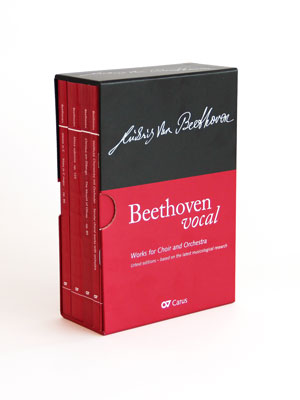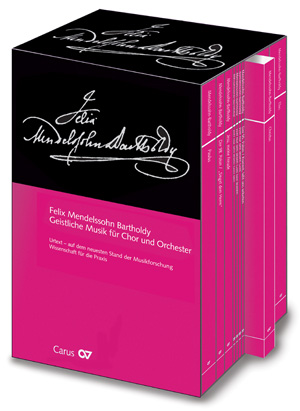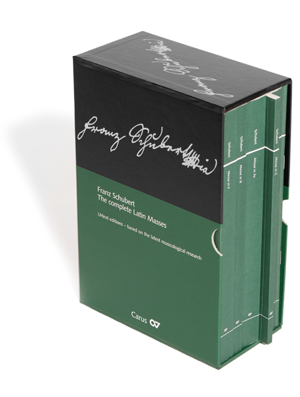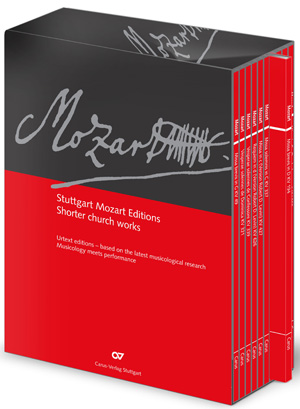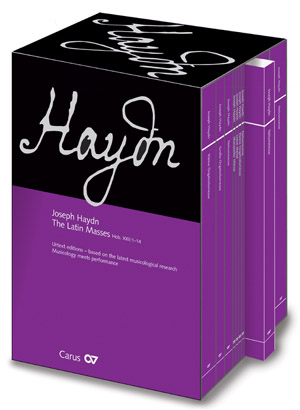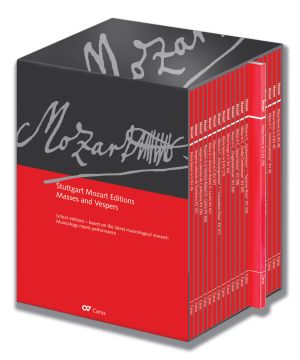
Wolfgang Amadeus Mozart Alle Messen und Vespern als Studienpartituren im Schuber
 Zusatz-Material
Zusatz-Material
-
 Text (ohne Noten) zum Abdruck, html-Datei, Singtext, engl. Übersetzunghtml-Datei, Singtext, engl. Übersetzung (Leseprobe)
Text (ohne Noten) zum Abdruck, html-Datei, Singtext, engl. Übersetzunghtml-Datei, Singtext, engl. Übersetzung (Leseprobe)1. Dixit Dominus (Soli SATB e Coro SATB)
The Lord said to my Lord:
sit thou at my right hand,
until I make thine enemies thy footstool.
The Lord will send forth the sceptre of thy power out of Sion:
rule thou in the midst of thine enemies.
With thee is the principality in the day of thy strength in the brightness of the saints:
from the womb before the morning star I begot thee.
The Lord hath sworn, and He will not repent:
Thou art a priest for ever
according to the order of Melchisedech.
The Lord at thy right hand hath broken kings in the day of His wrath.
He shall judge among nations,
He shall fill ruins:
He shall crush the heads in the land of many.
He shall drink of the torrent in the way:... -
 Text (ohne Noten) zum Abdruck, html-Datei, Singtext, deutsche Übersetzunghtml-Datei, Singtext, deutsche Übersetzung (Leseprobe)
Text (ohne Noten) zum Abdruck, html-Datei, Singtext, deutsche Übersetzunghtml-Datei, Singtext, deutsche Übersetzung (Leseprobe)1. Dixit Dominus (Soli SATB e Coro SATB)
Der Herr sprach zu meinem Herrn:
Setze dich zu meiner Rechten,
bis ich deine Feinde
zum Schemel deiner Füße lege.
Der Herr wird das Zepter deiner Macht ausstrecken aus Zion:
Herrsche mitten unter deinen Feinden!
Wenn du dein Heer aufbietest, wird dir dein Volk
willig folgen in heiligem Schmuck.
Deine Kinder werden dir geboren wie der Tau aus der Morgenröte.
Der Herr hat geschworen, und es wird ihn nicht gereuen:
Du bist ein Priester ewiglich nach der Weise Melchisedeks.
Der Herr zu deiner Rechten
wird zerschmettern die Könige am Tage seines Zorns.
Er wird richten unter den Heiden, wird viele erschlagen,... -
 Text (ohne Noten) zum Abdruck, html-Datei, Singtext, originalhtml-Datei, Singtext, original (Leseprobe)
Text (ohne Noten) zum Abdruck, html-Datei, Singtext, originalhtml-Datei, Singtext, original (Leseprobe)1. Dixit Dominus (Soli SATB e Coro SATB)
Dixit Dominus Domino meo:
Sede a dextris meis:
Donec ponam inimicos tuos,
scabellum pedum tuorum.
Virgam virtutis tuae emittet Dominus ex Sion:
dominare in medio inimicorum tuorum.
Tecum principium in die virtutis tuae
in splendoribus sanctorum:
ex utero ante luciferum genui te.
Juravit Dominus, et non poenitebit eum:
Tu es sacerdos in aeternum secundum ordinem Melchisedech.
Dominus a dextris tuis,
confregit in die irae suae reges.
Judicabit in nationibus, implebit ruinas:
conquasabit capita in terra multorum.
De torrente in via bibet:
propterea exaltabit caput.
Psalm 109... -
 Text (ohne Noten) zum Abdruck, html-Datei, Einführungstext, englischhtml-Datei, Einführungstext, englisch (Leseprobe)
Text (ohne Noten) zum Abdruck, html-Datei, Einführungstext, englischhtml-Datei, Einführungstext, englisch (Leseprobe)Text from the CD Carus 83.316
Konrad Küster (2000)
Translation (abridged): John CoombsThey occupy a position between Mozart’s settings of the Mass and his single-movement “shorter church works”: the substantial, multi-movement litanies and psalm cycles written while he was still at Salzburg. Undoubtedly their composition allowed him greater musical freedom than the settings of the Mass; because the latter were written for use at services which were organized down to the time allowed for the individual sections, the music had to be constructed along carefully defined lines.
On the other hand the vespers and litanies were not performed for Sunday or festival Masses, but in different liturgical circumstances. For the Offices of the Canonical Hours, even in the days of Gregorian plainsong, far more elaborate chants were used than at High Mass; vespers (the service at... -
 Text (ohne Noten) zum Abdruck, html-Datei, Einführungstext, deutschhtml-Datei, Einführungstext, deutsch (Leseprobe)
Text (ohne Noten) zum Abdruck, html-Datei, Einführungstext, deutschhtml-Datei, Einführungstext, deutsch (Leseprobe)Booklet-Text der CD Carus 83.316
Konrad Küster (2000)
Sie stehen zwischen den Messzyklen und den einsätzigen »kleineren Kirchenwerken« Mozarts: die umfangreichen, mehrsätzigen Litaneien und Psalmzyklen aus seiner Salzburger Zeit. Unverkennbar war in ihnen die musikalische Freiheit des Komponisten größer als in den Messzyklen: Weil diese sich in den Messgottesdienst einzufügen hatten, der bis in Details seines zeitlichen Ablaufes durchorganisiert war, bewegt sich auch die Musik in einem klar definierten Rahmen. Je nach Bedeutung des Gottesdienstes ermöglichte dieser zwar die Bildung eigenständiger Sätze (in der Missa solemnis), konnte aber auch die musikalischen Formen so begrenzen, wie es für die Missa brevis typisch ist; wenn beispielsweise am Ende von Gloria und Credo fugische Elemente entfaltet werden, dann nur als Andeutung weiter reichender Konzepte, und wenn zu den Worten »Et incarnatus est« der Eindruck eines eigenen
... -
 Text (ohne Noten) zum Abdruck, html-Datei, Singtext, engl. Übersetzunghtml-Datei, Singtext, engl. Übersetzung (Leseprobe)
Text (ohne Noten) zum Abdruck, html-Datei, Singtext, engl. Übersetzunghtml-Datei, Singtext, engl. Übersetzung (Leseprobe)1. Dixit Dominus (Soli SATB e Coro SATB)
The Lord said to my Lord:
sit thou at my right hand,
until I make thine enemies thy footstool.
The Lord will send forth the sceptre of thy power out of Sion:
rule thou in the midst of thine enemies.
With thee is the principality in the day of thy strength in the brightness of the saints:
from the womb before the morning star
I begot thee.
The Lord hath sworn, and He will not repent:
Thou art a priest for ever
according to the order of Melchisedech.
The Lord at thy right hand hath broken kings in the day of His wrath.
He shall judge among nations,
He shall fill ruins:
He shall crush the heads in the land of many.
He shall drink of the torrent in the way:... -
 Text (ohne Noten) zum Abdruck, html-Datei, Singtext, deutsche Übersetzunghtml-Datei, Singtext, deutsche Übersetzung (Leseprobe)
Text (ohne Noten) zum Abdruck, html-Datei, Singtext, deutsche Übersetzunghtml-Datei, Singtext, deutsche Übersetzung (Leseprobe)1. Dixit Dominus (Soli SATB e Coro SATB)
Der Herr sprach zu meinem Herrn:
Setze dich zu meiner Rechten,
bis ich deine Feinde
zum Schemel deiner Füße lege.
Der Herr wird das Zepter deiner Macht ausstrecken aus Zion:
Herrsche mitten unter deinen Feinden!
Wenn du dein Heer aufbietest,
wird dir dein Volk willig folgen in heiligem Schmuck.
Deine Kinder werden dir geboren wie der Tau aus der Morgenröte.
Der Herr hat geschworen, und es wird ihn nicht gereuen:
Du bist ein Priester ewiglich
nach der Weise Melchisedeks.
Der Herr zu deiner Rechten wird zerschmettern die Könige am Tage seines Zorns.
Er wird richten unter den Heiden, wird viele erschlagen,
wird Häupter zerschmettern über große Lande.
Er wird trinken vom Bach auf dem Wege,... -
 Text (ohne Noten) zum Abdruck, html-Datei, Singtext, originalhtml-Datei, Singtext, original (Leseprobe)
Text (ohne Noten) zum Abdruck, html-Datei, Singtext, originalhtml-Datei, Singtext, original (Leseprobe)1. Dixit Dominus (Soli SATB e Coro SATB)
Dixit Dominus Domino meo:
Sede a dextris meis:
Donec ponam inimicos tuos,
scabellum pedum tuorum.
Virgam virtutis tuae emittet Dominus ex Sion:
dominare in medio inimicorum tuorum.
Tecum principium in die virtutis tuae
in splendoribus sanctorum:
ex utero ante luciferum genui te.
Juravit Dominus, et non poenitebit eum:
Tu es sacerdos in aeternum
secundum ordinem Melchisedech. Dominus a dextris tuis,
confregit in die irae suae reges.
Judicabit in nationibus, implebit ruinas:
conquasabit capita in terra multorum.
De torrente in via bibet:
propterea exaltabit caput.
Psalm 109... -
 Text (ohne Noten) zum Abdruck, html-Datei, Singtext, originalhtml-Datei, Singtext, original (Leseprobe)
Text (ohne Noten) zum Abdruck, html-Datei, Singtext, originalhtml-Datei, Singtext, original (Leseprobe)Kyrie (ST, Coro)
Kyrie eleison.
Christe eleison.
Kyrie eleison.Gloria (SATB, Coro)
Gloria in excelsis Deo.
Et in terra pax hominibus bonae voluntatis.
Laudamus te. Benedicimus te. Adoramus te. Glorificamus te.
Gratias agimus tibi propter magnam gloriam tuam.
Domine Deus, Rex coelestis, Deus Pater omnipotens.
Domine Fili unigenite, Jesu Christe.
Domine Deus, Agnus Dei, Filius Patris.
Qui tollis peccata mundi, miserere nobis,
suscipe deprecationem nostram.
Qui sedes ad dexteram Patris, miserere nobis.
Quoniam tu solus Sanctus.
Tu solus Dominus.
Tu solus Altissimus, Jesu Christe.
Cum Sancto Spiritu, in gloria Dei Patris.... -
 Text (ohne Noten) zum Abdruck, html-Datei, Einführungstext, englischhtml-Datei, Einführungstext, englisch (Leseprobe)
Text (ohne Noten) zum Abdruck, html-Datei, Einführungstext, englischhtml-Datei, Einführungstext, englisch (Leseprobe)Abridged Foreword of the Edition Carus 40.618
Ulrich Leisinger
Translation: John CoombsThe name “Coronation Mass” by which the Missa in C major KV 317 of Wolfgang Amadeus Mozart is generally known, is historically misleading (Mozart did not compose it for a coronation, and so far as is known at present it was never performed at one during his lifetime), but the name says a great deal about the role of this work in the increasing appreciation of Mozart’s church music by succeeding generations. Mozart himself regarded this as one of the most important among his settings of the Mass. […] The date, the full scoring of the work, and its dimensions – substantially greater that those of the Missae breves written about the middle of the 1770s – suggest that this work was probably intended for performance at Easter 1779 (Easter Sunday that year was on the 6th April).
In accordance with the instructions given by Archbishop Colloredo, the Prince-Bishop of Salzburg, all the movements of this work are laid out concisely. Elaborate contrapuntal sections, such as fugues to conclude the Gloria and Credo, are avoided. As in other masses, Mozart did not compose the Agnus Dei in the original key, to which
... -
 Text (ohne Noten) zum Abdruck, html-Datei, Einführungstext, deutschhtml-Datei, Einführungstext, deutsch (Leseprobe)
Text (ohne Noten) zum Abdruck, html-Datei, Einführungstext, deutschhtml-Datei, Einführungstext, deutsch (Leseprobe)Gekürztes Vorwort der Ausgabe Carus 40.618
Ulrich Leisinger
In den Jahrzehnten nach Mozarts Tod, in denen sich seine Werke rasch verbreiteten, ein Werkverzeichnis zur eindeutigen Identifizierung einer bestimmten Komposition aber fehlte, haben sich viele Beinamen eingebürgert, die zum größeren Teil bis heute lebendig geblieben sind. Wenn die Missa in C KV 317 unter der Bezeichnung „Krönungsmesse“ allgemein bekannt ist, so ist dieser Ehrentitel zwar historisch irreführend (Mozart selbst hat sie nämlich weder für eine Krönung geschrieben, noch nach derzeitigem Kenntnisstand bei einer solchen aufgeführt), doch besagt er viel über die Rolle, die dieser Messe in der Rezeptionsgeschichte der Kirchenmusik Wolfgang Amadeus Mozarts zukommt. In der Wertschätzung des Komponisten, des ausgehenden 18. Jahrhunderts und weiten Teilen des 19. Jahrhunderts zählt sie zu seinen bedeutendsten Messkompositionen. Mozarts selbst hat sie sich vom Vater aus Salzburg nach München, später nach Wien nachschicken lassen; um 1790 verlieh er Partitur und Originalstimmen an seinen Freund Anton Stoll, der sie als Regenschori in Baden bei Wien aufgeführt hat. […] Neben der Missa solemnis in C KV 337 gehört sie damit seit gut zwei
... -
 Text (ohne Noten) zum Abdruck, html-Datei, Singtext, originalhtml-Datei, Singtext, original (Leseprobe)
Text (ohne Noten) zum Abdruck, html-Datei, Singtext, originalhtml-Datei, Singtext, original (Leseprobe)Kyrie (Coro)
Kyrie eleison
Christe eleison
Kyrie eleisonGloria (Soli SATB, Coro)
Et in terra pax hominibus bonae voluntatis.
Laudamus te. Benedicimus te. Adoramus te. Glorificamus te.
Gratias agimus tibi propter magnam gloriam tuam.
Domine Deus, Rex caelestis. Deus Pater omnipotens.
Domine Fili Unigenite. Jesu Christe.
Domine Deus, Agnus Dei, Filius Patris.
Qui tollis peccata mundi,
miserere nobis.
Qui tollis peccata mundi,
suscipe deprecationem nostram.
Qui sedes ad dexteram Patris,
miserere nobis.
Quoniam tu solus Sanctus.
Tu solus Dominus.
Tu solus Altissimus,
... -
 Text (ohne Noten) zum Abdruck, html-Datei, Einführungstext, englischhtml-Datei, Einführungstext, englisch (Leseprobe)
Text (ohne Noten) zum Abdruck, html-Datei, Einführungstext, englischhtml-Datei, Einführungstext, englisch (Leseprobe)Abridged Foreword of the Edition Carus 40.623
Willi Schulze
Translation: E. D. EcholsOn no other Mozart mass has professional opinion differed so widely as on the Missa brevis in G Major KV 140. While Mozart biographer Otto Jahn labelled the work “superficial and light” and Alfred Einstein, in the Köchel Catalogue, expressed doubt as to the “authenticity of this flat work,” Franz Lorenz had already called attention in his investigation of Mozart’s masses3 to the work’s “purity of feeling” and “lovely charm of expression” as clearly revealing Mozart’s masterly skill. This opinion was shared by Altmann Kellner who, after discovering an early copy of the work in the Kremsmünster Monastery and then making critical comparisons, became convinced that this mass is “genuine Mozart.”
While to earlier researchers the sources known to them caused doubts as to Mozart’s autorship, the unusual style of the work gave rise to still other questions. Otto Jahn felt that the 6/8 beginning of the Gloria and the transition to 3/8 time for “Laudamus te” were “striking divergences” from Mozart’s other treatment of the Gloria text. Too, Franz Lorenz misses Mozart’s “so unique inner fire,” but
... -
 Text (ohne Noten) zum Abdruck, html-Datei, Einführungstext, deutschhtml-Datei, Einführungstext, deutsch (Leseprobe)
Text (ohne Noten) zum Abdruck, html-Datei, Einführungstext, deutschhtml-Datei, Einführungstext, deutsch (Leseprobe)Gekürztes Vorwort der Ausgabe Carus 40.623
Willi Schulze
Keine Messe Mozarts ist in der Fachliteratur so unterschiedlich beurteilt worden wie die Missa brevis in G KV 140. Während der Mozartbiograph Otto Jahn das Werk als „oberflächlich und leichtfertig“ bezeichnet und Alfred Einstein im Köchelverzeichnis die „Echtheit des platten Werkes“ bezweifelt, hatte schon Franz Lorenz in seiner Arbeit über Mozarts Messen auf die „Reinheit der Empfindung“ und die „holdselige Lieblichkeit des Ausdrucks“ hingewiesen, die deutlich Mozarts Meisterschaft verraten würden. Diesem Urteil schloss sich Altmann Kellner an, der im Stift Kremsmünster eine frühe Kopie des Werkes entdeckte und auf Grund kritischer Vergleiche zu der Überzeugung gelangte, diese Messe sei „ein echter Mozart“.
Den Beginn des Gloria im 6/8-Takt und den Übergang zum 3/8-Takt bei Laudamus te empfand schon Otto Jahn als „auffallende Abweichung“ von Mozarts sonstiger Behandlung des Gloria-Textes. Auch Franz Lorenz vermisst das Mozart „so eigenthümliche innere Feuer“, ist aber andererseits – im Gegensatz zu Jahn – besonders von dem Laudamus te beeindruckt und fragt mit Recht: „Wer unter den damaligen
... -
 Text (ohne Noten) zum Abdruck, html-Datei, Singtext, originalhtml-Datei, Singtext, original (Leseprobe)
Text (ohne Noten) zum Abdruck, html-Datei, Singtext, originalhtml-Datei, Singtext, original (Leseprobe)Kyrie (Soli SA, Coro)
Kyrie eleison.
Christe eleison.
Kyrie eleison.Gloria (Soli SATB, Coro)
[Gloria in excelsis Deo]
Et in terra pax hominibus bonae voluntatis.
Laudamus te. Benedicimus te.
Adoramus te. Glorificamus te.
Gratias agimus tibi propter magnam gloriam tuam.
Domine Deus, Rex caelestis,
Deus Pater omnipotens.
Domine Fili unigenite, Jesu Christe.
Domine Deus, Agnus Dei, Filius Patris.
Qui tollis peccata mundi,
miserere nobis.
Qui tollis peccata mundi,
suscipe deprecationem nostram.
Qui sedes ad dexteram Patris,
miserere nobis.... -
 Text (ohne Noten) zum Abdruck, html-Datei, Einführungstext, englischhtml-Datei, Einführungstext, englisch (Leseprobe)
Text (ohne Noten) zum Abdruck, html-Datei, Einführungstext, englischhtml-Datei, Einführungstext, englisch (Leseprobe)Abridged foreword of the Edition Carus 40.624
Jochen Reutter
Translation: John CoombsDuring the summer of 1774 W. A. Mozart wrote two Masses within a few weeks: the Missa brevis in F major, K. 192 (186f), and the Missa brevis in D major, K. 194 (186h). A feature common to both compositions as well as to the Dixit et Magnificat K. 193 (186g), written at about the same time, and the "Trinitatis" Mass K. 167 of the previous year, is a more or less strongly evident tendency towards contrapuntal writing. However, while the Dixit et Magnificat and the "Trinitatis" Mass approach the late-baroque style, in these two brevis Masses Mozart sought to combine traditional polyphonic techniques with a more modern musical language.
The Missa brevis in F major was completed on the 24th June 1774, as is stated on the autograph score. It is clear from an authentic set of performing parts, containing markings in Mozart's hand, that this work was intended for Salzburg Cathedral. In accordance with the modest requirements of a missa brevis, the orchestra consists only of two violins, bass and organ, the so-called "church trio." They were augmented, as the local performing practice demanded,... -
 Text (ohne Noten) zum Abdruck, html-Datei, Einführungstext, deutschhtml-Datei, Einführungstext, deutsch (Leseprobe)
Text (ohne Noten) zum Abdruck, html-Datei, Einführungstext, deutschhtml-Datei, Einführungstext, deutsch (Leseprobe)Gekürztes Vorwort der Ausgabe Carus 40.624
Jochen Reutter
Im Sommer 1774 schrieb W. A. Mozart in unmittelbarer zeitlicher Nachbarschaft zwei Messen, die Missa brevis in F KV 192 (186f) und die Missa brevis in D KV 194 (186h). Beiden Kompositionen eigen ist wie dem etwa gleichzeitig entstandenen Dixit et Magnificat KV 193 (186g) und der aus dem Vorjahr stammenden Trinitatismesse KV 167 eine jeweils mehr oder weniger stark ausgeprägte Neigung zur kontrapunktischen Schreibweise. Während sich jedoch Dixit et Magnificat und die Trinitatismesse dem spätbarocken Stil nähern, sucht Mozart in den beiden brevis-Messen die althergebrachten polyphonen Techniken mit einer moderneren Tonsprache zu verbinden.
Die Missa brevis in F wurde, so das Datum auf der autographen Partitur, am 24. Juni 1774 beendet. Sie war, wie eine authentische Stimmenabschrift mit eigenhändigen Eintragungen Mozarts bezeugt, für den Salzburger Dom bestimmt. Dem bescheideneren Anspruch einer Missa brevis gemäß ist das Orchester nur mit zwei Violinen, Bass und Orgel, dem sog. "Kirchentrio", besetzt. Hinzu kommen der lokalen Aufführungspraxis entsprechend... -
 Text (ohne Noten) zum Abdruck, html-Datei, Singtext, originalhtml-Datei, Singtext, original (Leseprobe)
Text (ohne Noten) zum Abdruck, html-Datei, Singtext, originalhtml-Datei, Singtext, original (Leseprobe)Kyrie
Kyrie eleison.
Christe eleison.
Kyrie eleison.Gloria
Et in terra pax hominibus bonae voluntatis.
Laudamus te. Benedicimus te. Adoramus te. Glorificamus te.
Gratias agimus tibi propter magnam gloriam tuam.
Domine Deus, Rex caelestis, Deus Pater omnipotens.
Domine Fili unigenite, Jesu Christe.
Domine Deus, Agnus Dei, Filius Patris.
Qui tollis peccata mundi, miserere nobis,
Qui tollis peccata mundi,
suscipe deprecationem nostram.
Qui sedes ad dexteram Patris, miserere nobis.
Quoniam tu solus Sanctus.
Tu solus Dominus.Tu solus Altissimus, Jesu Christe.
Cum Sancto Spiritu, in gloria Dei Patris.
Amen.... -
 Text (ohne Noten) zum Abdruck, html-Datei, Einführungstext, englischhtml-Datei, Einführungstext, englisch (Leseprobe)
Text (ohne Noten) zum Abdruck, html-Datei, Einführungstext, englischhtml-Datei, Einführungstext, englisch (Leseprobe)Foreword of the edition Carus 40.625
Jochen Reutter
Translation: John CoombsDuring the summer of 1774 W. A. Mozart wrote two Masses within a few weeks: the Missa brevis in F major, K. 192 (186f), and the Missa brevis in D major, K. 194 (186h). A feature common to both compositions as well as to the Dixit et Magnificat K. 193 (186g), written at about the same time, and the "Trinitatis" Mass K. 167 of the previous year, is a more or less strongly evident tendency towards contrapuntal writing. However, while the Dixit et Magnificat and the "Trinitatis" Mass approach the late-baroque style, in these two brevis Masses Mozart sought to combine traditional polyphonic techniques with a more modern musical language.
The Missa brevis in D major, K. 194 (186h), was written shortly after its sister-work in F major. Mozart's autograph score is dated the 8th August 1774. This work, like K. 192 (186f), was intended for Salzburg Cathedral. Corresponding to the restricted scale of a missa brevis, Mozart wrote the F major Mass, and also the present work, for a small ensemble of four voices (SATB), choral and solo, two violins, bass and organ, together with the three trombones
... -
 Text (ohne Noten) zum Abdruck, html-Datei, Einführungstext, deutschhtml-Datei, Einführungstext, deutsch (Leseprobe)
Text (ohne Noten) zum Abdruck, html-Datei, Einführungstext, deutschhtml-Datei, Einführungstext, deutsch (Leseprobe)Vorwort der Ausgabe Carus 40.625
Jochen Reutter
Im Sommer 1774 schrieb W.A. Mozart in unmittelbarer zeitlicher Nachbarschaft zwei Messen, die Missa brevis in FKV 192 (186f) und die Missa brevis in D KV 194 (186h). Beiden Kompositionen eigen ist wie dem etwa gleichzeitig entstandenen Dixit et Magnificat KV 193 (186g) und der aus dem Vorjahr stammenden Trinitatismesse KV 167 eine jeweils mehr oder weniger stark ausgeprägte Neigung zur kontrapunktischen Schreibweise. Während sich jedoch Dixit et Magnificat und die Trinitatismesse dem spätbarocken Stil nähern, sucht Mozart in den beiden brevis-Messen die althergebrachten polyphonen Techniken mit einer moderneren Tonsprache zu verbinden.
Die Missa brevis in D KV 194 (186h) entstand nur wenige Wochen nach ihrer F-Dur-Schwester. Mozarts autographe Partitur ist auf den 8. August 1774 datiert. Das Werk war wie KV 192 (186f für den Salzburger Dom bestimmt. Dem äußeren Rahmen einer Missa brevis entspricht Mozart wie in der F-Dur-Messe durch eine sparsame Besetzung mit vier Singstimmen (SATB), chorisch und
... -
 Text (ohne Noten) zum Abdruck, html-Datei, Singtext, engl. Übersetzunghtml-Datei, Singtext, engl. Übersetzung (Leseprobe)
Text (ohne Noten) zum Abdruck, html-Datei, Singtext, engl. Übersetzunghtml-Datei, Singtext, engl. Übersetzung (Leseprobe)Kyrie (Soli e Coro)
Lord, have mercy on us.
Christ, have mercy on us.
Lord, have mercy on us.Gloria (Soli e Coro)
And on earth peace to men of good will.
We praise thee; we bless thee; we adore thee; we glorify thee.
We give thee thanks for thy great glory.
Lord God, heavenly King,
God the almighty Father.
O Lord, the only-begotten Son, Jesus Christ,
O Lord God, Lamb of God, Son of the Father.... -
 Text (ohne Noten) zum Abdruck, html-Datei, Singtext, deutsche Übersetzunghtml-Datei, Singtext, deutsche Übersetzung (Leseprobe)
Text (ohne Noten) zum Abdruck, html-Datei, Singtext, deutsche Übersetzunghtml-Datei, Singtext, deutsche Übersetzung (Leseprobe)Kyrie (Soli e Coro)
Herr, erbarme dich.
Christus, erbarme dich.
Herr, erbarme dich.Gloria (Soli e Coro)
Und Friede auf Erden den Menschen seiner Gnade.
Wir loben dich, wir preisen dich, wir beten dich an, wir rühmen dich
und danken dir, denn groß ist deine Herrlichkeit:
Herr und Gott, König des Himmels,
Gott und Vater, Herrscher über das All,
Herr, eingeborener Sohn, Jesus Christus.
Herr und Gott, Lamm Gottes, Sohn des Vaters,
du nimmst hinweg die Sünde der Welt: erbarme dich unser;
du nimmst hinweg die Sünde der Welt: nimm an unser Gebet;... -
 Text (ohne Noten) zum Abdruck, html-Datei, Singtext, originalhtml-Datei, Singtext, original (Leseprobe)
Text (ohne Noten) zum Abdruck, html-Datei, Singtext, originalhtml-Datei, Singtext, original (Leseprobe)Kyrie (Soli e Coro)
Kyrie eleison
Christe eleison.
Kyrie eleison.Gloria (Soli e Coro)
Et in terra pax hominibus bonae voluntatis.
Laudamus te. Benedicimus te. Adoramus te. Glorificamus te.
Gratias agimus tibi propter magnam gloriam tuam.
Domine Deus, Rex caelestis,
Deus Pater omnipotens.
Domine Fili unigenite Jesu Christe.
Domine Deus, Agnus Dei, Filius Patris.
Qui tollis peccata mundi, miserere nobis.
Qui tollis peccata mundi, suscipe deprecationem nostram.
Qui sedes ad dexteram Patris, miserere nobis.
Quoniam tu solus sanctus.
Tu solus Dominus. Tu solus Altissimus, Jesu Christe.
Cum Sancto Spiritu, in gloria Dei Patris.
Amen.Credo (Soli e Coro)
... -
 Text (ohne Noten) zum Abdruck, html-Datei, Einführungstext, englischhtml-Datei, Einführungstext, englisch (Leseprobe)
Text (ohne Noten) zum Abdruck, html-Datei, Einführungstext, englischhtml-Datei, Einführungstext, englisch (Leseprobe)Abridged Foreword of the Edition Carus 40.626
Bertold Over
Translation: John CoombsThe composition of the Mass in C, popularly known as the “Spatzenmesse” (Sparrow Mass), dates from Mozart’s time as concertmaster at the Court of the Archbishop of Salzburg. That position, which he had held as a salaried employee from the 9th July 1772 – during the preceding years he had held it in an honorary capacity – offered him very wide scope for composing, and made many demands on him. During that period he wrote for the Court a great deal of instrumental music, church music and dramatic music (the serenata Il sogno di Scipione and Il rè pastore). This Mass in C probably dates from 1775–76, and it is in many respects an exceptional work among the compositions of Mozart, who was then aged about twenty.
This Mass belongs to the class of the Missa brevis et solemnis, much cultivated in southern Germany and Austria during the 18th century. The Missa brevis is a Mass which is concise in construction, and which generally contains no lengthy vocal solos. It is intended for use by a fairly small ensemble, for performance not at High Mass on major feast days, but for masses on
... -
 Text (ohne Noten) zum Abdruck, html-Datei, Einführungstext, deutschhtml-Datei, Einführungstext, deutsch (Leseprobe)
Text (ohne Noten) zum Abdruck, html-Datei, Einführungstext, deutschhtml-Datei, Einführungstext, deutsch (Leseprobe)Gekürztes Vorwort der Ausgabe Carus 40.626
Berthold Over
Die Entstehung der Missa in C, der so genannten „Spatzenmesse“, fällt in Mozarts Zeit als Konzertmeister am Salzburger Hof. Diese Position, die er seit dem 9. Juli 1772 mit fester Besoldung innehatte – in den Jahren davor bekleidete er sie ehrenhalber –, bot ihm die vielfältigsten kompositorischen Möglichkeiten und Herausforderungen. Für den Hof schrieb er in dieser Zeit viel Instrumentalmusik, Kirchenmusik und dramatische Musik (die Serenata Il sogno di Scipione und Il rè pastore). Die Missa in C entstand wahrscheinlich 1775–76 und stellt für das damalige Schaffen des knapp zwanzigjährigen Mozart in vielerlei Hinsicht eine Besonderheit dar.
Die Messe gehört zum Typus der im 18. Jahrhundert in Süddeutschland und Österreich verbreiteten Missa brevis et solemnis. Die Missa brevis an sich ist eine Messe, die insgesamt kürzer gefasst ist und weitgehend auf ausgedehnte Soli verzichtet. Sie weist eine kleinere Besetzung auf und ist nicht für festliche Hochämter an hohen Festtagen gedacht, sondern für Messen an Sonn- und weniger wichtigen Festtagen. Eine
... -
 Text (ohne Noten) zum Abdruck, html-Datei, Singtext, originalhtml-Datei, Singtext, original (Leseprobe)
Text (ohne Noten) zum Abdruck, html-Datei, Singtext, originalhtml-Datei, Singtext, original (Leseprobe)Kyrie
Kyrie eleison.
Christe eleison.
Kyrie eleison.Gloria
Et in terra pax hominibus bonae voluntatis.
Laudamus te. Benedicamus te. Adoramus te. Glorificamus te.
Gratias agimus tibi propter magnam gloriam tuam.
Domine Deus, Rex caelestis, Deus Pater omnipotens.
Domine Fili unigenite, Jesu Christe.
Domine Deus, Agnus Dei, Filius Patris.
Qui tollis peccata mundi, miserere nobis,
suscipe deprecationem nostram.
Qui sedes ad dexteram Patris, miserere nobis.
Quoniam tu solus Sanctus.
Tu solus Dominus.
Tu solus Altissimus, Jesu Christe.
Cum Sancto Spiritu, in gloria Dei Patris.
Amen.Credo
... -
 Text (ohne Noten) zum Abdruck, html-Datei, Einführungstext, englischhtml-Datei, Einführungstext, englisch (Leseprobe)(
Text (ohne Noten) zum Abdruck, html-Datei, Einführungstext, englischhtml-Datei, Einführungstext, englisch (Leseprobe)(Abrigded Foreword of the Edition Carus 40.629/03
Bernhard Janz
Translation: John CoombsTo a greater extent than almost any others, Mozart's Masses combine a very high degree of artistic accomplishment and tonal beauty with fulfilment of the demands made by the Liturgy. Even the textually expansive movements Gloria and Credo are, in most of Mozart's Masses, short enough to meet the requirements of a festive service, today as in his time. The choral parts are not too difficult for well-trained amateur singers, and in most cases even the solo sections are – given the necessary technical ability, vocal qualities and careful preparation – performable by non-professional singers. In addition, Mozart's church compositions frequently require only a small instrumental ensemble, which can be assembled relatively easily even when resources are limited; in common with all of Mozart's other Masses in the brevis class, the present work can be performed accompanied by a chamber orchestra consisting of violins, basses (double bass, cello, and possibly bassoon) and organ.
As the autograph score of Mozart's Mass in B flat KV 275, which may have shown the date of composition, has been lost since the 19th
... -
 Text (ohne Noten) zum Abdruck, html-Datei, Einführungstext, deutschhtml-Datei, Einführungstext, deutsch (Leseprobe)
Text (ohne Noten) zum Abdruck, html-Datei, Einführungstext, deutschhtml-Datei, Einführungstext, deutsch (Leseprobe)Gekürztes Vorwort der Ausgabe Carus 40.629/03
Bernhard Janz
Mozarts Messen erfreuen sich in der kirchenmusikalischen Praxis großer und noch immer steigender Beliebtheit: Wie nur wenige andere Vertonungen des Ordinariums verbinden sie hohe künstlerische Vollendung und Klangschönheit mit den Erfordernissen der Liturgie; selbst die textreichen Sätze Gloria und Credo haben in den meisten dieser Messen einen Umfang, der dem zeitlichen Rahmen eines feierlichen Gottesdienstes auch unserer Tage noch durchaus angemessen ist. Zudem übersteigen die technischen Ansprüche an die Ausführenden kaum jemals die Grenzen dessen, was von gut geschulten Laiensängern zu bewältigen ist; sogar die Soloabschnitte lassen sich mitunter – das technische Können, die stimmlichen Qualitäten und eine sorgfältige Einstudierung vorausgesetzt – auch von nicht professionellen Kräften ausführen. Außerdem begnügen sich die Kirchenkompositionen Mozarts nicht selten mit einem Instrumentalensemble, das auch in beschränkten Verhältnissen noch relativ leicht zusammenzustellen ist: Wie alle Mozart-Messen des brevis-Typs kommt auch die hier vorliegende Messe mit einem
...
Inhaltsverzeichnis
-
Komponist*in
Wolfgang Amadeus Mozart
| 1756-1791Als Sohn des Vizekapellmeisters des Salzburger Fürsterzbischofs war Mozart bereits in seiner Jugend beständig von Kirchenmusik umgeben. Auf seinen Reisen lernte Mozart die Kirchenmusik Italiens kennen, in Wien studierte er später Werke Bachs und Händels. Nach seiner Umsiedlung nach Wien stellen sich mit Oper und Klavierkonzert neue Herausforderungen, bezeichnenderweise bleibt die „c-Moll-Messe“ KV 427, das größte kirchenmusikalische Werk der ersten Wiener Jahre, unvollendet. Die letzte Lebenszeit zeigt wieder eine Hinwendung zur Kirchenmusik: Mozart bewirbt sich mit Erfolg um die Nachfolge des todkranken Leopold Hoffmann als Kapellmeister am Stephansdom, doch kann er die Stelle nicht antreten, da er noch vor Hoffmann stirbt. Ein Kleinod wie das „Ave verum“ KV 618 und das unvollendet gebliebene Requiem KV 626 lassen ahnen, was Mozart als Kirchenkomponist hätte noch leisten können, wäre er in diese verantwortliche Position gelangt. zur Person
Rezensionen
[...] Wherever possible Mozart's autographs have been consulted and the scores prepared by established scholars using modern editorial conventions which are clearly identified. Also helpful is the policy of including commentary in three languages - German, English and French - as well as critical notes on sources and alternative readings. Not only are questions of historic practice and performance discussed, but attention is also given to such matters as providing playable piano reductions in the vocal scores. Even more attractive is the publisher's policy in respect of the performance material. [...]
Denis McCaldin
Bewertungen auf unserer Website können nur von Kund*innen mit registriertem Nutzerkonto abgegeben werden. Eine Überprüfung, ob die bewerteten Produkte tatsächlich erworben wurden, findet nicht statt.
Häufige Fragen zum Werk
 An dieser Stelle gibt es noch gar keine Fragen und Antworten zum Werk oder Ihre spezifische Frage zum Werk wurde noch nicht beantwortet? Klicken Sie hier und reichen Sie Ihre werkspezifische Frage bei unserem Kundenservice ein!
An dieser Stelle gibt es noch gar keine Fragen und Antworten zum Werk oder Ihre spezifische Frage zum Werk wurde noch nicht beantwortet? Klicken Sie hier und reichen Sie Ihre werkspezifische Frage bei unserem Kundenservice ein!




